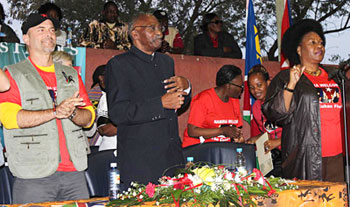

Vol. 79/No. 26 July 27, 2015

|
| Gerardo Hernández, left, one of the Cuban Five, with Peter Katjavivi, speaker of Namibia’s National Assembly, at July 4 event in Windhoek during recent tour of southern Africa. |
This was the second country the Five visited in southern Africa to strengthen the internationalist ties between Cuba and the peoples of the region. The tour started in South Africa June 21 and ended in Angola July 8. They were invited to Namibia by SWAPO, which led the struggle against South African occupation that won independence in 1990.
The Cuban Five — Gerardo Hernández, Ramón Labañino, Antonio Guerrero, Fernando González and René González —spent up to 16 years in U.S. prisons on frame-up charges. The final three returned to Cuba in December as part of the agreement to move toward re-establishing diplomatic relations between Washington and Havana, a victory for the people of Cuba, their government and the international campaign demanding their freedom.
Hernández, Fernando González and René González served as internationalist combatants in Angola before taking assignments to go to the U.S. to monitor counterrevolutionary groups that have carried out violent attacks against the Cuban Revolution with Washington’s complicity.
In 1975 the Angolan government turned to revolutionary Cuba, requesting help to beat back a military invasion by the South African apartheid regime. Some 375,000 Cubans volunteered for combat in Angola over 16 years. They helped repel repeated incursions, culminating in the victorious 1988 battle at Cuito Cuanavale, where the South African army suffered a military defeat at the hands of the combined forces of the Angolan army, Cuban internationalists and SWAPO combatants.
It was “one of the decisive turning points in Southern African history and brought the white minority regime in South Africa to its knees,” Nujoma said at the reception.
“You don’t see big media making reference to Cuito Cuanavale,” Hernández said, addressing the reception. “For them that battle didn’t exist. The media of the empire want to offer a completely different history of Africa that erases the role of our compatriots, erases the role of Cuban internationalists.”
Rulers fear revolutionary example
“They fear the example that we represented,” Hernández said. “That example goes beyond Cuba and the Cuban Revolution.”“The fact that we kept firm in our ideals,” he said, referring to the failed attempt to break the spirit of the Five in prison, “went against the script they want people to believe.”
The U.S. rulers want people to believe that the Cuban Revolution and the fight for independence of Namibia are “just a moment in history,” he said, and when the historic leaders of those movements are gone “the revolution will cease to exist.”
“They are wrong,” Hernández said. “Both in Cuba and Namibia there are new generations that feel inspired by the example of Fidel Castro, Nelson Mandela, Sam Nujoma. A new generation that is willing to sacrifice their lives to keep going forward.”
Nujoma described the barbaric attack on the Cassinga Refugee Camp in 1978, when more than 1,000 Namibians lost their lives. Cuban forces repelled the South African troops and managed to take hundreds of people to safety.
“The children who survived the massacre were taken to Cuba,” he said. Two schools were established on the Isle of Youth there where thousands of young Namibians were educated.
During their four days in Namibia the Five visited the Heroes’ Acre, a monument dedicated to those who paid with their lives in the centuries-long fight for independence. They took part in a solidarity march with 1,000 supporters and a meeting of some 2,000 — Namibians, Cubans and members of the diplomatic corps. Next February, Namibia will host a continental solidarity event with Cuba, according to Prensa Latina.
“Our internationalist mission helped us in prison in the U.S., to rise above our imprisonment,” René González said during their two-day visit to Angola. “We fulfilled our mission here, but we also learned a lot from the Angolans, from their dignity, generosity and affection. I also think it made us grow.”
The Five were invited to Angola by the governing MPLA party, the Angolan Parliament, solidarity organizations and the Angola League of Friendship with the Peoples. Gen. Armando da Cruz Neto of the MPLA leadership received them at the airport, where the Organization of Angolan Women had organized a welcoming reception.
In addition to meeting government representatives and solidarity organizations, they laid a wreath at the monument of Agostinho Neto, Angola’s first president after liberation from Portugal’s colonial rule in 1975. They also visited the Alto Las Cruces cemetery to pay tribute to Raúl Diaz Argüelles, the first head of the Cuban military mission in Angola, who died in 1975 in the southern province of Cuanza Sul after an anti-tank mine explosion.
Related articles:
Greece: New book is tool to defend Cuban Revolution
‘Ukraine gov’t should restart Cuba-Chernobyl program
Front page (for this issue) | Home | Text-version home